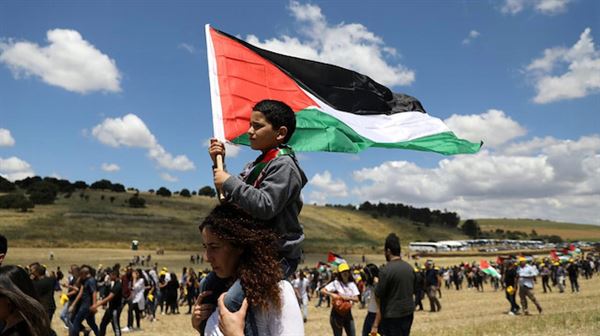Even as 139 countries in the world have already recognized Palestine as a state, it continues under the occupation and siege of Israel. More than thre
Even as 139 countries in the world have already recognized Palestine as a state, it continues under the occupation and siege of Israel.
More than three decades have passed since Palestine declared independence, yet this cause remains unfulfilled as the Israeli occupation continues and recognition by major world powers is lacking.
On Nov. 15, 1988, the Palestine National Council, the legislative body of the Palestine Liberation Organization (PLO), issued the Palestinian Declaration of Independence.
The announcement was made by the late prominent Palestinian leader Yasser Arafat from Algeria, in which he stated that Jerusalem is the eternal capital of Palestine.
Notably, Arafat’s announcement was not the first of its kind, as the ‘All-Palestine Government’ declared the first document of independence in October 1948.
As the British Mandate came to an end, Israel declared independence on May 14, 1948, prompting the Arab countries — including Egypt, Syria, Lebanon and Jordan — to wage war against it.
The All-Palestine Government was formed in Gaza on Sept. 22, 1948 during the war and declared independence.
After winning the war, Israel invaded and occupied Western Jerusalem.
In the 1967 Arab-Israeli War, Israel invaded all of Palestine by entering East Jerusalem, the West Bank and the Gaza Strip.
Occupation
According to the Palestinian Central Bureau of Statistics, Israel occupies around 85% of the historical territory of Palestine.
The total occupation of East Jerusalem became the largest obstacle to resolving the Palestinian-Israeli conflict. Israel fully occupies the historical city, which forms the heart of the Palestinian cause.
Meanwhile, more than 316,000 Palestinians live in East Jerusalem, and those who refuse to hold Israeli citizenship use Jerusalem identity cards as residence permits.
Attempts by Israel to annex East Jerusalem include a Knesset resolution in 1980 in which it declared western and eastern parts of the city the “eternal and united” capital of Israel.
The annexation motion was condemned by UN Security Council Resolution 478 the same year.
On Dec. 6, 2017, U.S. President Donald Trump signed a decree that recognized Jerusalem as the “capital” of Israel. Then, on May 14, 2018, the U.S. relocated its embassy from Tel Aviv to Jerusalem.
Israel has been pushing other countries to follow in the footsteps of the U.S. in recognizing Jerusalem as the Israeli capital, including persuading them to relocate their diplomatic missions from Tel Aviv to Jerusalem.
The West Bank remains under Israeli occupation following the 1967 War, where Israel began to administrate it and build illegal Jewish settlements.
Some 500,000 Jewish settlers currently live in some 250 illegal settlements in the West Bank.
Palestinian institutions are located in Ramallah city, and due to the barrier wall, Palestinians in the West Bank cannot enter Jerusalem unless Israel allows them, mostly during the Muslim holy month of Ramadan when individuals below 12 or above 40 years old can access the city.
Blockade
The Gaza Strip was occupied as well one year after 1967 where Israel also started building settlements on 23,000 square kilometers of land and annexed another 23,000 square kilometers on the pretext of setting up “safe areas” near the new settlements.
Israeli Prime Minister Ariel Sharon, in response to the armed resistance in Gaza, put a “disengagement plan” on the agenda which called for the evacuation of Jewish settlements from the region for the first time.
On June 15, 2005, Israel evacuated the settlers and withdrew from Gaza after demolishing the settlement buildings.
After the Hamas organization won Palestinian legislative elections and became the governing force in Gaza, Israel imposed a blockade on the enclave, where some two million Palestinians live.
Since 2006, there has been an aerial, land and sea blockade of the Gaza Strip, leading to one of the world’s worst humanitarian crises.
Recognition timeline
The Palestinian state was first recognized by 90 countries, including Turkey, in 1988 and it now enjoys the recognition of 139 countries.
However, major countries including the U.S., the U.K., France and Germany still do not recognize the Palestinian state.
At its 67th meeting on Nov. 29, 2012, the UN General Assembly voted in favor of a resolution granting Palestine the status of a non-member observer state at the UN.
In late 2014, the European parliaments held symbolic votes in favor of recognizing Palestine, calling on their governments to officially recognize the Palestinian state, according to the Palestinian news agency Wafa.
On April 1, 2015, Palestine became a member of the International Criminal Court.
On Sept. 30, 2015, the Palestinian flag was raised for the first at the UN.
On Nov. 23, 2015, the majority of UN General Assembly member states called on Israel to end its occupation of the Palestinian territories, stressing the need for a comprehensive solution to the Palestinian cause.
On Dec. 19, 2017, the UN General Assembly passed a resolution reaffirming Palestinians’ right to self-determination — a resolution that garnered support from 176 countries and objection from seven states, including Israel and the U.S.
